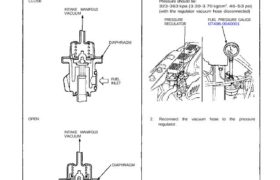Description
The fuel pressure regulator maintains a constant fuel
pressure to the injectors. When the difference between
the fuel pressure and manifold pressure exceeds 3.5
kg/cm2 (50 psi), the diaphragm is pushed upward, and
the excess fuel is fed back into the fuel tank through the
return line.
CLOSE
Testing
Do not smoke during the test. Keep
open flames away from your work area.
1. Attach a pressure gauge to the service port of the
fuel filter (page 11-88).
Pressure should be:
323-363 kpa (3.30-3.70 kg/cm2. 46-53 psi)
(with the regulator vacuum hose disconnected)
PRESSURE FUEL PRESSURE GAUGE
REGULATOR 07406-0040001
INTAKE MANIFOLD
VACUUM
DIAPHRAGM
FUEL
INLET
2. Reconnect the vacuum hose to the pressure
regulator.
OPEN
INTAKE MANIFOLD
VACUUM
DIAPHRAGM
FUEL
INLET
(cont’d)
Fuel Supply System
Pressure Regulator (cont’d)
3. Check that the fuel pressure rises when the vacuum
hose from the regulator is disconnected again.
If the fuel pressure did not rise, check to see if it
rises with the fuel return hose lightly pinched.
If the fuel pressure still does not rise, replace the
pressure regulator.
Replacement
Do not smoke while working on fuel sys-
tem . Keep open flame away from work area.
1. Place a shop towel under pressure regulator, then
relieve fuel pressure (page 11-87).
2. Disconnect the vacuum hose and fuel return hose.
3. Remove the two 6 mm retainer bolts.
O-RING
Replace.
PRESSURE REGULATOR
RETURN HOSE SHOP TOWEL
NOTE:
Replace the O-ring.
When assembling the regulator, apply clean engine
oil to the O-ring and assemble it into its proper
position, taking care not to damage the O-ring.
